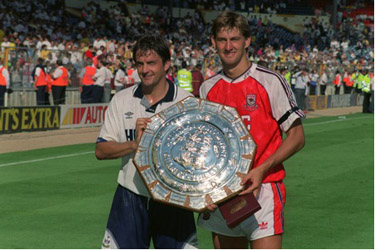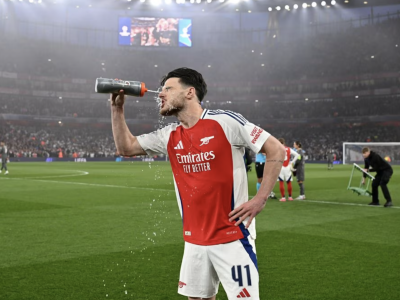In 1971, as you’re all aware, Arsenal undoubtedly qualified to take part in that year’s Charity Shield on account of winning both the Football League and FA Cup the previous season. The only shadow of a doubt should have therefore been who would be their opponents. The only precedent for this had come ten years prior when Tottenham Hotspur carried out the same feat. They then took on an England XI at White Hart Lane. The FA Charity Shield that year however took place between the Champions of the Second Division - Leicester City – and the runners up in the 1971 FA Cup Final, Bill Shankly’s Liverpool at Leicester’s Filbert Street.
The reason behind Arsenal’s absence is that in the eight days leading up to the start of the 1971/72 season the club had already been committed to partake in a pre-season friendly against Benfica in Lisbon, followed by a fixture against Feyenoord in Rotterdam and asserted they were unable to pull out of the fixture with Benfica, which had already been cancelled as a result of their hectic run-in the previous May. The refusal to cancel a lucrative friendly had also been a matter of principle due to the stink the club kicked up three years earlier, when South American club champions - Estudiantes of Argentina - pulled out of friendly fixture with Arsenal, (who instead went off to play a friendly with Inter), as a result of the fall-out from their ill-tempered second leg of the World Club Championship fixture with European Cup winners Man Utd at Old Trafford, which led to a sending off for George Best.
Throughout the 1960s the Charity Shield was achieving respectable attendance figures, the 1967 fixture between Man Utd and Spurs achieving 54,000 on the gate. Arsenal’s snub in 1971 however was a huge dent in its credibility, setting a precedent where both League Champions Derby and FA Cup holders Leeds Utd also snubbed the 1972 fixture with fourth placed Man City meeting Third Division Champions Aston Villa at Villa Park. The same occurred in 1973 when Man City, purely because they were holders, met Second Division champions Burnley at Maine Road. In 1974 however, the FA had made it compulsory that the Football League Champions and FA Cup holders participate and that the fixture would now be played at Wembley Stadium. The 1974 game also has historical significance in that it had been Bill Shankly’s last game in charge of Liverpool and Brian Clough’s first in his short 44 day managerial reign at Leeds. Keegan and Bremner’s famous bust up also ensured it was a far from friendly affair.
Arsenal’s first appearance at Wembley in the Charity Shield came against Liverpool in 1979, however they were played off the park by the Merseysiders who took the Shield, winning 3-1. Liverpool would also be victorious a decade later for Arsenal’s next appearance as League Champions in 1989, however it is doubtful this victory for Liverpool had made up for either Arsenal’s last ditch title win at Anfield the previous May or the fact that every other non-Charity Shield Wembley fixture between the two sides has ended in an Arsenal victory. Arsenal were back again as League Champions in 1991, however the match with FA Cup holders Tottenham Hotspur was so non-descript that it seems that clearly no-one has bothered to upload it on any video sharing websites such as YouTube, with the only real proof for those born after 1991 that Arsenal and Spurs actually shared a trophy that year being the picture at the top of this article.
Another change of format therefore was to follow, in order to prevent another such a damp squib as the 1991 fixture being repeated in the future. The FA Charity Shield now had a sponsor, in the form of Tennants Lager, and was to be broadcast live on Sky Sports. For either to get their money’s worth out of a fixture involving the League Champions and the FA Cup winners, it had to become a marquee event and for both sides to share the trophy at the end of a draw was never going to suffice. Arsenal were to be involved in the Charity Shield again two years later (in what was their fifth Wembley appearance in under four months), the needs of television had meant that the game had to kick off at 12.45 PM in order to avoid clashing with League fixtures kicking off during the 3PM black out period.
The 1993 match became the first Charity Shield since 1974 to be decided by a penalty shootout (though George Graham at the time claimed he was unaware that a drawn match was to be decided in this fashion). Ian Wright’s screamer of a volley had cancelled out Mark Hughes’s opener, and ironically as in 1974 the game would be decided by a penalty miss by a goalkeeper. David Seaman failed to convert the deciding penalty in 1993, where nineteen years earlier it was Leeds United goalkeeper David Harvey whose miss from the spot had handed Liverpool the Charity Shield.
Over eleven seasons, the fixture was to be contested by Arsenal and Manchester United on no fewer than four occasions. The rivalry between Sir Alex Ferguson and Arsene Wenger went some way to inflating the importance of the Charity Shield as both managers saw it as an opportunity to strike an early psychological blow in the title race. The first head to head between Wenger and Ferguson came after Arsenal’s double in 1998 and was David Beckham’s first game in England after his infamous sending off against Argentina just a few weeks prior. An interesting time piece to note ahead of this fixture is Arsene Wenger confidently predicted the coming of a European Super League over the next few years (though in realty, a pipe dream which sixteen years on looks even less likely than it did then). In the event however, Arsenal comprehensively triumphed 3-0 on the day.
In the follow up fixture a year on, Arsenal’s appearance came by virtue of finishing second in the Premiership and took place in the aftermath of Man Utd’s treble and the controversy surrounding their plans to withdraw from that season’s FA Cup. Arsenal retained the Shield in a 2-1 victory over their rivals from the North, however it turned out to be their only silverware during the 1999/2000 season. In the aftermath of their 2000 FA Cup victory, a Chelsea supporting supervisor at work taunted me by asking what Arsenal had won that season. I replied sarcastically: ‘the Charity Shield… which is a proper trophy as United actually bothered to enter it’. It also turned out to be Arsenal’s final appearance at the old Wembley Stadium in any competition. With their next appearance in this fixture in 2002 came not just a change of venue (now held at the Millennium Stadium in Cardiff) but also a change of name for the competition.
Ahead of the 2002 fixture, the Charity Commission had claimed that the FA had breached Charity rules by failing to inform fans who the recipients of the proceeds of the fixture would be and so the fixture was to be rebranded as the FA Community Shield as a result. In the first ever FA Community Shield, Double winners Arsenal took on Premiership runners up Liverpool, winning 1-0. Ahead of the Invincible season, Arsenal would line up against Man United again, but despite a sublime Thierry Henry free kick cancelling out a Mikel Silvestre goal for United, Arsenal would again lose the Shield on a penalty shoot-out.
Arsenal would win the Shield back a year later with a 3-1 victory and goals from Gilberto, Reyes and an own goal from future Arsenal centre half Silvestre, but would concede the 2005 Shield to Chelsea in a 1-2 defeat, which would be their last appearance in the competition for another nine years. On their return in 2014, as FA Cup winners Arsenal saw off Premiership Champions Man City with a promising 3-0 victory. The importance of beating the Premiership champions by any score in this fixture however will always be something of a moot point.
Other European countries do have a similar fixture of League Champions up against Cup winners, usually referred to as the ‘Super Cup’. This Daily Telegraph article argues the case for taking the fixture abroad in the pre-season, citing the example of the Italian and French counterparts – the Italian Super Cup was played in Washington DC as early as 1993 and has since been played in the Libyan capital of Tripoli, Beijing and Qatar; while the French Super Cup since 2008 has been exported on an annual basis to venues in Montreal, Tunisia, Morocco, Gabon and China.
Playing the Community Shield abroad is not an entirely unreasonable proposition and one with far more integrity than the 39th Premiership fixture proposal of a few years ago. However, while our ‘Super Cup’ equivalent has a veneer of charity to it, the FA will probably not go to the trouble of exporting a fixture which they can’t rinse every last commercial ounce out of for private gain.
That said however, with a ‘traditional’ fixture like this, which seems to have shown a David Bowie-like knack for reinvention over the years, you can never really say never.
*Follow me on Twitter@robert_exley







